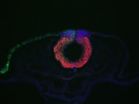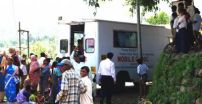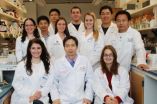(Press-News.org) (Santa Barbara, Calif.) –– UC Santa Barbara has reported an important discovery in the interdisciplinary study of split-brain research. The findings uncover dynamic changes in brain coordination patterns between left and right hemispheres.
Split-brain research has been conducted for decades, and scientists have long ago shown that language processing is largely located in the left side of the brain. When words appear only in the left visual field –– an area processed by the right side of the brain –– the right brain must transfer that information to the left brain, in order to interpret it. The new study at UCSB shows that healthy test subjects respond less accurately when information is shown only to the right brain.
While hemispheric specialization is considered accurate, the new study sheds light on the highly complex interplay –– with neurons firing back and forth between distinct areas in each half of the brain. The findings rely on extremely sensitive neuroscience equipment and analysis techniques from network science, a fast-growing field that draws on insights from sociology, mathematics, and physics to understand complex systems composed of many interacting parts. These tools can be applied to systems as diverse as earthquakes and brains.
Fifty years ago, UC Santa Barbara neuroscientist Michael S. Gazzaniga moved the field forward when he was a graduate student at the California Institute of Technology and first author of a groundbreaking report on split-brain patients. The study, which became world-renowned, was published in the Proceedings of the National Academy of Sciences (PNAS) in August 1962. This week, in the very same journal, Gazzaniga and his team announced major new findings in split-brain research. The report is an example of the interdisciplinary science for which UCSB is well known.
"The occasion of this paper is on the 50th anniversary of the first report on human split-brain research reported in PNAS," said Gazzaniga. "That study showed how surgically dividing the two hemispheres of the human brain –– in an attempt to control epilepsy –– allowed for studying how each isolated half-brain was specialized for cognitive function.
"In the present study, new techniques –– not present 50 years ago –– begin to allow for an understanding of how the normal, undivided brain integrates the special functions of each half brain. It is a new beginning and very exciting," said Gazzaniga, professor of psychology in UCSB's Department of Psychological and Brain Sciences, and director of UCSB's SAGE Center for the Study of Mind.
Karl W. Doron, first author and a postdoctoral scholar with Gazzaniga, said: "This study shows that the strength of communication across the brain changes dynamically, when information is exchanged between the right and left hemispheres via the corpus callosum, which connects both sides of the brain. The findings shed light on the neural underpinnings of inter-hemispheric communication first reported 50 years ago in the classic split-brain studies performed by Gazzaniga and colleagues."
Doron explained that years of research –– in both clinical patient populations and healthy individuals –– have shown that the brain is made up of specialized modules that preferentially process certain types of information.
When linguistic information, such as a word or pronounceable non-word, is shown directly to the left brain, people are better at deciding whether or not it is a real word, said Doron.
"In contrast, when the information is shown directly to the right brain, people perform worse," he said. "It has long been assumed that language information shown to the right brain must be transferred through the corpus collosum. In other words, right brain information must be directly transferred to the language-specialized left brain, in order to be processed correctly."
In the new study, researchers used magnetoencephalography, or MEG, a non-invasive tool that measures the continuous brain activity of nine healthy young adults. The participants were briefly flashed a stimulus that was either a real word or a "word-like" non-word. The stimulus was randomly shown either to the left or right brain, using a split-visual field experimental technique.
MEG allows researchers to peer into brain activity at the rate of 512 images per second, while fMRI only allows for images to be recorded at the rate of one image every two seconds. The researchers processed this temporal data using novel network analysis techniques drawn from the mathematical and physical sciences that enable them to examine the dynamic nature of brain communication. This novel network analysis allows the data to be presented in movie form, rather than as snapshots. The researchers found that the strength of connections between the left and right hemispheres depended on whether the stimulus was shown to the left or right brain hemisphere.
"A larger number of statistically significant connections were present at several time points after the stimulus when the word or pronounceable non-word was shown to the right brain and needed to be transferred to the language-specialized left brain," said Danielle S. Bassett, UCSB Sage Junior Research Fellow in the Departments of Physics and the Department of Psychological and Brain Sciences.
"The results further suggest that brain function measured with MEG can be broken into functional communities that rearrange their organization over time –– based on whether the left or right brain saw the stimulus, and thus whether inter-hemispheric information transfer must take place," said Bassett.
While working on his Ph.D. with Gazzaniga, which he completed in 2011, Doron directed the MEG experiments at the Otto-von-Guericke University in Magdeburg, Germany over a two-month period, with support from Gazzaniga's German Humboldt Fellowship Award. The MEG machine is composed of a vertical cylinder that is positioned over the head and held in place with a type of helmet.
Doron's research combines data from cognitive experiments with a variety of neuroimaging modalities to understanding the neuroscientific underpinnings of the mind, with specific focus on neural oscillatory processes and attention. Doron's current work merges graph theoretical, information theoretical, and complex systems approaches in an effort to describe the large-scale functional connectivity of brain networks.
Bassett's education is highly interdisciplinary, with studies in physics, mathematics, psychology, and neuroscience funded by the Winston Churchill Scholarship and the NIH-Cambridge Scholarship. She received her Ph.D. in physics at the University of Cambridge where she had supervisors in several disciplines, including psychiatry. Her current studies are carried out within UCSB's Departments of Physics, and Psychological and Brain Sciences, and the Sage Center for the Study of the Mind. She was recently recognized with the Alumni Achievement Award for extraordinary professional accomplishment before age 35 from her alma mater, the Schreyer Honors College and Penn State University.
Gazzaniga has contributed remarkable advances in the understanding of functional lateralization in the brain, and how the cerebral hemispheres communicate with one another. He has published many books, which are accessible to a lay audience, such as Mind Matters and Nature's Mind. His many scholarly publications include the landmark 1995 book for MIT Press, The Cognitive Neurosciences, now in its fourth edition, and recognized as the sourcebook for the field. He is the founder and former editor-in-chief of the Journal of Cognitive Neuroscience, and was a member of the President's Council on Bioethics from 2001-2008.
INFORMATION:
UCSB scientists report 'new beginning' in split-brain research, using new analytical tools
2012-11-02
ELSE PRESS RELEASES FROM THIS DATE:
California is home to extreme weather, too
2012-11-02
MERCED, Calif. — California isn't going to face a superstorm like Hurricane Sandy because the Pacific Ocean is too cold to feed that kind of weather system.
But that doesn't mean California won't see extreme weather, say researchers from the University of California, Merced.
"We can see very big storms, and there are a couple of issues related to climate change to think about," said Roger Bales, director of the Sierra Nevada Research Institute. "Most of our biggest storms are snow storms, which builds up snowpack in the mountains. The snowpack is a reservoir, storing ...
Developmental bait and switch
2012-11-02
PASADENA, Calif.—During the early developmental stages of vertebrates—animals that have a backbone and spinal column, including humans—cells undergo extensive rearrangements, and some cells migrate over large distances to populate particular areas and assume novel roles as differentiated cell types. Understanding how and when such cells switch their purpose in an embryo is an important and complex goal for developmental biologists. A recent study, led by researchers at the California Institute of Technology (Caltech), provides new clues about this process—at least in the ...
Weill Cornell receives $1.5 million in Grand Challenges Explorations grants
2012-11-02
NEW YORK (Nov. 01, 2012) -- Weill Cornell Medical College announced today that it is a Grand Challenges Explorations winner, an initiative funded by the Bill & Melinda Gates Foundation. Researchers at Weill Cornell have been awarded three research grants totaling more than $1.5 million. Weill Cornell's Dr. Juan R. Cubillos-Ruiz, a postdoctoral research associate in medicine in the laboratory of Dean Dr. Laurie H. Glimcher, will pursue an innovative global health and development research project titled, "Tailored Nanodevices to Understand Resistance Against HIV," Dr. Carl ...
New medication shows promise as lipid-lowering therapy for rare cholesterol disorder
2012-11-02
PHILADELPHIA – An international effort led by researchers at the Perelman School of Medicine at the University of Pennsylvania has resulted in positive phase 3 clinical trial results for a new medicine to treat patients suffering from a rare and deadly cholesterol disorder.
Penn researchers report in The Lancet that lomitapide, a first-in-class microsomal triglyceride transfer protein (MTP) inhibitor, substantially and stably reduced LDL cholesterol (the "bad" cholesterol) in patients with the orphan disease homozygous familial hypercholesterolemia (HoFH). Lomitapide ...
Brain imaging alone cannot diagnose autism
2012-11-02
Belmont, MA— In a column appearing in the current issue of the journal Nature, McLean Hospital biostatistician Nicholas Lange, ScD, cautions against heralding the use of brain imaging scans to diagnose autism and urges greater focus on conducting large, long-term multicenter studies to identify the biological basis of the disorder.
"Several studies in the past two years have claimed that brain scans can diagnose autism, but this assertion is deeply flawed," said Lange, an associate professor of Psychiatry and Biostatistics at Harvard Medical School. "To diagnose autism ...
When considering bariatric surgery think about bones
2012-11-02
Bariatric surgery, which significantly curtails the amount of food a person can eat, is the most effective treatment against obesity and is being recognized as a potentially valuable tool in the fight against diabetes related to obesity. It is being performed on increasing numbers of people worldwide, including teenagers.
Unfortunately, some types of bariatric surgery may also cause bone loss, a cause for concern, particularly when carried out on young people who have not yet reached their peak bone mass, say endocrinologists from Sydney's Garvan Institute of Medical ...
Temporary storage for electrons: Natural method of producing hydrogen
2012-11-02
Scientists at the Max Planck Institute for Chemical Energy Conversion (MPI CEC) and the Ruhr-Universität Bochum (RUB) have found through spectroscopic investigations on a hydrogen-producing enzyme that the environment of the catalytic site acts as an electron reservoir in the enzyme. Thus, it can very efficiently produce hydrogen, which has great potential as a renewable energy source. The research team describes their results in the journal "Angewandte Chemie".
Producing hydrogen with enzymes
The system analysed constitutes an enzyme that catalyses the formation and ...
Health project in India saved many mothers and children
2012-11-02
Infant mortality has fallen by half, and the number of women who died from complications during pregnancy and childbirth by three-quarters. This is the result of a four-year health care project in one of India's poorest districts.
"We're overjoyed that mortality could be reduced with relatively simple means like mobile health care centres. It was successful because pregnant women and new mothers got the opportunity to actively seek care."
So says Siw Alehagen who, together with AnnaKarin Johansson, Orvar Finnström and Göran Hermansson – all of Linköping University ...
MRI research sheds new light on nerve fibers in the brain
2012-11-02
World-leading experts in Magnetic Resonance Imaging from The University of Nottingham's Sir Peter Mansfield Magnetic Resonance Centre have made a key discovery which could give the medical world a new tool for the improved diagnosis and monitoring of brain diseases like multiple sclerosis.
The new study, published in the Proceedings of the National Academy of Science, reveals why images of the brain produced using the latest MRI techniques are so sensitive to the direction in which nerve fibres run.
The white matter of the brain is made up of billions of microscopic ...
New finding gives clues for overcoming tamoxifen-resistant breast cancer
2012-11-02
CINCINNATI—A University of Cincinnati (UC) cancer biology team reports breakthrough findings about specific cellular mechanisms that may help overcome endocrine (hormone) therapy-resistance in patients with estrogen-positive breast cancers, combating a widespread problem in effective medical management of the disease.
Xiaoting Zhang, PhD, and his colleagues have identified a specific estrogen receptor co-activator—known as MED1—as playing a central role in mediating tamoxifen resistance in human breast cancer. The team reports its findings in the Nov. 1, 2012, issue of ...



